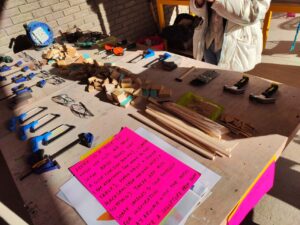Learning Sprint 2 | Open Toolkits: Reflective Analysis
I have been just been commissioned to create an Artist’s Toolkit that is a comprehensive open educational resource (OER). I’ve been advised that I should avoid making assumptions about the learners that will use this Toolkit. Since I will only be paid when I complete the commission, I have very few resources at my disposal. How might I achieve this task?
In this week’s Sprint, we have been studying and researching for the open Toolkits. At the beginning of this Sprint, the question of what is a Toolkit actually bothered me. Thanks to the teachers who followed up with a wealth of open educational resources, I gradually came to understand the definition of a Toolkit.
Toolkit is a collection of materials and instructions that people need for self-directed learning. It can assist people to learn more efficiently and at the same time facilitate the dissemination of knowledge for the purpose of sharing educational resources. When we were first introduced to OER, we raised some negative points during group discussions, such as the possibility that someone might take advantage of the information gap in OER to make money or even cheat; and it was a question to ponder whether less driven students would be able to stick with the Toolkit for their studies. However, there is no denying that OER is a good idea, and as internet technology and electronic devices become more widespread, it will become more widely known and used, providing the same educational resources and equal learning opportunities to users around the world.
In this Sprint we were exposed to two types of Toolkits, one of which was an offline workshop where we visited the Edinburgh Sculpture Workshop on 13 October and experienced three types of toolkits, including the mud club, wood carving and the Communication Station. In participating in each Toolkit, we were provided with the appropriate specialist materials and tools. For example, for the mud club we used clay, fruit and carving tools, for the wood carving Toolkit we were given wood and specialist tools such as saws, files, drilling tools and hot melt glue guns, while the Communication Station provided an already established communication base and we just had to think about how to link it up. It takes a lot of money and effort to prepare these specialist tools and materials. In the scenario that the commission is paid only after completion and few resources are at the disposal, this workshop format of the toolkit is not applicable.



Another situation that we experienced that was more appropriate in the scenario was the online Toolkit. With the guidance of our teachers, we browsed the toolkit websites The Art Assignment, Learning to Love you More, Art Assign Bot and Wicked Arts Assignments, where we could select assignments of interest and create art according to the instructions on the pages. Compared to the first offline Toolkit, the online format makes it easier for participants to take part by removing geographical restrictions. There is also a greater degree of freedom, as participants are not restricted to a particular material, but can create their own artwork using materials that are close to them.
When creating the Toolkit, we should give participants clear instructions on how to complete the appropriate learning. It is also important to allow participants a certain degree of freedom, as we need to avoid making assumptions about the learners who use the Toolkit. The participants in the toolkit may come from all over the world and have different life experiences and learning backgrounds, so each person’s ideas for a common assignment will be different. As the Toolkit maker, we should give the participants maximum freedom to accomplish the creative goals they have in mind and provide a platform for them to share and communicate on the website, so as to achieve the purpose of open learning.




Using her experience as an example, the author describes the operation of two different kinds of art toolkits, and concludes with suggestions for developing the art toolkits in the last paragraph. However, the author’s response to scenario still seems to be vague. In scenario, the two points about how to distribute the art toolkit under the condition of limited funds and resources and how to make the art toolkit become an open educational resource are not solved (or even mentioned). It is expected that the author can get more inspirations to guide the scenario from her own experience.
Great to see you engaging fully with the concept of Toolkits (good description here) and connecting this back to the OER and open educational practices more widely. It’s true that the ESW Toolkits wouldn’t be feasible if you didn’t have money (up front) to pay for the materials. The challenge you have – in this respect – is a bit different to that faced by artists making kits for the ESW. It’s good to see you picking up on this and thinking through its implications here.
As you say, online Toolkits are, perhaps, more accessible and, in more cases, might be something we could create with little or no resources up-front. I wonder if, on reflection, you feel if any of the Toolkits you tested made assumptions about the learners who use the Toolkit? Were any of them ‘guilty’ of assuming a particular kind of life experience or learning background? If so, what, if anything, do you think might be done to adjust this?